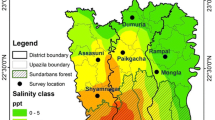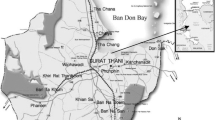Abstract
The extensive zero-water exchange shrimp farming system in the periphery of Chilka lagoon (Orissa, India) was studied. The study aimed to describe this unique farming system with special reference to dynamics of macrozoobenthos, production characteristics and economics. The study conducted was based on a general survey as well as monitoring of five individual farms over a complete production cycle. The farming practice in this area is characterized by complete absence of water exchange during rearing. Ponds in this area are generally shallow (mean 72 cm). Most of the water and soil quality characteristics of these farms are within acceptable levels. Macrozoobenthos belonging to 12 taxa were collected, amphipods (81%) and polychaetes (13%) being most numerous. Overall macrobenthic density of farms studied varied from 968 to 11,470 individuals/m2 with a gross mean of 5644 individuals/m2. There was no general pattern to the variation in abundance of various taxa in different phases of the rearing cycle, suggesting a low predatory pressure by shrimp in the farms studied. Shrimp production was highly variable (91–250 kg/ha), but generally low with a mean of 145 kg/ha. The net income of these farms was estimated to be Rs. 63,250 per crop per ha. Compared with shrimp farming system with regular water exchange in the same area, Chilka farms generated high benefit-cost ratio indicating high profitability and sustainability.
Similar content being viewed by others
References
Anonymous 2000. Handbook on Fisheries Statistics, Orissa, 2001–01. Directorate of Fisheries, Orissa, India, pp. 117.
Aravindakshan, P. N., Balasubramanian, T., Lalithambikadevi, C. B., Nair, K. K. C., Gopalakrishnan, T. C., Jayalakshmi K. V. and Krishnankutty, M. 1992. Benthos and substratum characteristics of prawn culture elds in and around the Cochin Backwater. Journal of Marine Biological Association of India 34: 203–217.
Baird, I. G. and Quarto, A. 1994. The environmental social costs of developing coastal shrimp aquaculture in Asia. In: Trade and Environment in Asia-Pacific: Prospects for Regional Cooperation, Nautilus Institute for Security and Sustainable Development, California, USA, pp. 188–214.
Biswas, K. P. 1995. Ecological and Fisheries Development in Wetlands. Daya Publishing House, New Delhi, India, 192 pp.
Brennan, D., Clayton, H., Be, T. T. and Heip, T. T. N. 1999. Economic and social characteristics and farm management practices of farm in the brackish water of Soc Trang and Bac Lieu provinces, Mekong Delta, Vietnam. Results of a 1997 survey. http://www.reap.com.au/riceshrimpsurvey97.pdf.
Cha. M. W., Young, L. and Wong, K. 1997. The fate of traditional extensive (gei wai) shrimp farming at the Mai Po Marshes Nature Reserve, Hong Kong, Hydrobiologia 352: 295–303.
Costa-Pierce, B. A. 2002. Ecological Aquaculture. Blackwell Science, Oxford, UK.
Dash, M. C. and Patnaik. P. N. 1994. Brackish Water Prawn Culture. Palani Paramount Publications, Palani, India, 233 pp.
Flegel, T. W., Boonyaratpalin, S. and Withyachumnamkul, B. 1996. Current status of research on Yellow–head virus and white spot virus in Thailand. In: Book of Abstracts, The 1996 Annual Meeting of the World Aquaculture Society. Bangkok, Thailand, 126 pp.
Hariati, A. M., Wiadnya, D. G. R., Tanck, M. W., Boon, J. H. and Verdegem, M. C. 1996. Penaeus monodon (Fabricius)production related to water quality in East Java, Indonesia. Aquaculture Research 27: 255–260.
Hopkins, J. S., Hamilton, R. D., Sandifer, P. A., Browdy, C. L. and Sokes, A. D. 1993. Effects of water exchange rate on production, water quality, e. uent characteristics and nitrogen budgets of intensive shrimp ponds. Journal of World Aquaculture Society 24(3): 304–320.
IUCN, 1987. India, In: IUCN (ed.), A Directory of Asian Wetlands, IUCN, Gland, Switzerland, pp. 367–505.
Johnson, D., Trong, N. V., Tien, D. V. and Xuan, T. T. 2000. Shrimp yield and harvest characterizations of mixed shrimp farms in Southern Vietnam: factors a. ecting production. Aquaculture 88: 263–284.
Kautsky, N., Ronnback, P., Tedengren, M. and Troell, M. 2000. Ecosystem perspectives on management of disease in shrimp pond farming. Aquaculture 191: 145–161.
Krumbein, W. C. and Petti John, C. T. 1938. Manuel of Sedimentary Petrography. Appleton Century-crofts, New York.
Lebel, L., Tri, N. H., Saengnoree, A., Pasong, S., Buatama, U. and Thoa, L. K. 2002. Industrial transformation and shrimp aquaculture in Thailand and Vietnam: pathway to ecological, social and economic sustainability? Ambio 31(4): 311–323.
Marte, C. L. 1980. The food and feeding habits of Penaeus monodon Fabricius collected from Makato River, Aklan, Philippines (Decapoda, Natantia). Crustaceana 38: 225–236.
Menasveta, P. 2002. Improved shrimp grow-out system for disease prevention and environmental sustainability in Asia. Reviews in Fisheries Science 10(3,4): 391–402.
Mohanty S. K. and Mitra, H. K. 1987. Case studies on the monoculture of tiger prawn Penaeus monodon (Fabricius) in con ned brackish water ponds in Puri and Ganjam Districts, Orissa. Journal of Indian Society of Coastal and Agriculture Research 5(10): 223–230.
Nunes, A. J. P. and Parsons, G. J. 1998. Dynamics of tropical coastal aquaculture system and the consequence to waste production. World Aquaculture 29: 27–37.
Nunes, A. J. P. and Parsons, G. J. 1999. Feeding levels of the southern Brown shrimp Penaeus subtilis in response to food dispersal. Journal of World Aquaculture Society 30: 331–348.
Nunes, A. J. P. and Parsons, G. J. 2000. Effect of southern brown shrimp, Penaeus subtilis predation and arti cial feeding on the population dynamics of benthic polychaetes in tropical pond enclosures. Aquaculture 183: 125–147.
Phillips, M. and Barg, U. 1999. Experiences and opportunities in shrimp farming. In: Sustainable Aquaculture, Balkema, Rotterdam, pp. 43–72.
Primavera, J. H. 1998. Tropical shrimp farming and sustainability. In: DeSilva, S. S. (ed. ), Tropical Mariculture. Academic Press, San Diego, pp. 257–289.
Rajyalakshmi, T., Mohanty, A. N., Ravichandran, P. and Pillai, S. M. 1988. The soil and water quality characteristics of con ned brackishwater ponds on Chilka Lake fringe area. In: Joseph, M. (ed. ), The First Indian Fisheries Forum. Asian Fisheries Society, Indian Branch, Mangalore, pp. 125–128.
Rajan, S. 1971. Environmental studies of the Chilka Lake 2 benthic animal communities. Indian Journal of Fisheries 12(2): 492–499.
Reyntjens, D. J. R. 1987. Con ned–pond Shrimp Farming near Chilka Lake. BOBP News issues 25: 8–12.
Rosenberry, R. 1990. World Shrimp Farming. Aquaculture Digest, San Diego, CA.
Rosenberry, R. 2000. World Shrimp Farming 1999, Annual report, Shrimp News International, San Diego, CA.
Rubright, J. S., Harrel, J. L., Holcomb, H. W. and Parker, J. C. 1981. Response of planktonic and benthic communities to fertilizers and feed applications in shrimp mariculture ponds. Journal of World Mariculture Society 12(1): 281–299.
Shang, Y. C., Leung, P. and Ling, B. H. 1998. Comparative economics of shrimp farming in Asia. Aquaculture 164: 183–200.
Shishehchian, F. and Yuso, F. M. 1999. Composition and abundance of macrobenthos in intensive tropical marine shrimp culture ponds. Journal of the World Aquaculture Society 30(1): 128–133.
Stirling, H. P. 1985. Specific chemical analysis. In: Stirling, H. P. (ed. ), Chemical and Biological Methods of Water Analysis for Aquaculturists. Institute of Aquaculture, University of Stirling, UK, pp. 33–85.
Vimstein, R. W. 1977. The importance of predation by crabs and shes on benthic in fauna in Chesapeake Bay. Ecology 58: 1199–1217.
Walkey, A. and Black, I. A. 1934. An examination of the Degrjarelf method for determining soil organic matter and proposed modi cation of the chromic acid titration method. Soil Science 37: 29–38.
Wang, J. K. 1990. Managing shrimp pond water to discharge problems. Aquaculture Engineering 9: 61–73.
Author information
Authors and Affiliations
Rights and permissions
About this article
Cite this article
Balasubramanian, C., Pillai, S. & Ravichandran, P. Zero-water exchange shrimp farming systems (extensive) in the periphery of Chilka lagoon, Orissa, India. Aquaculture International 12, 555–572 (2004). https://doi.org/10.1007/s10499-004-0350-3
Issue Date:
DOI: https://doi.org/10.1007/s10499-004-0350-3




